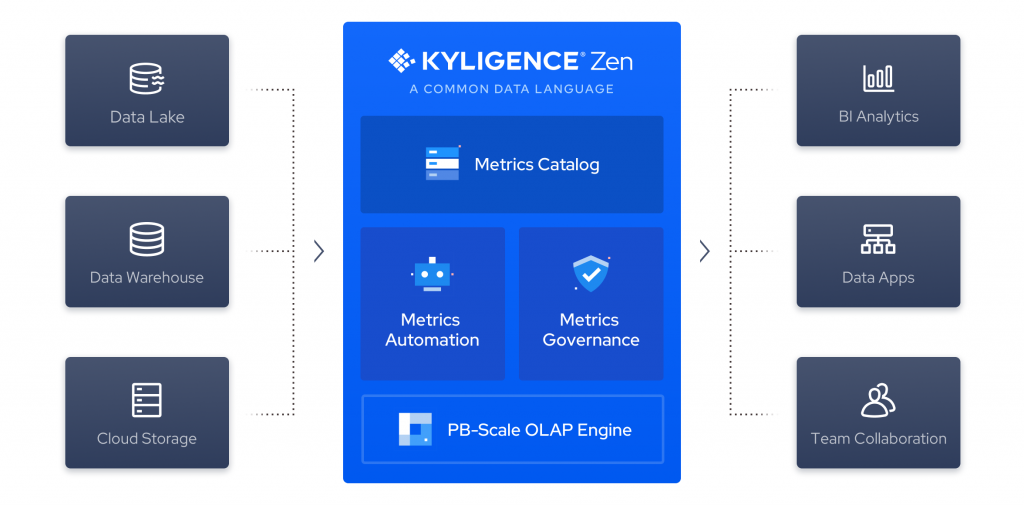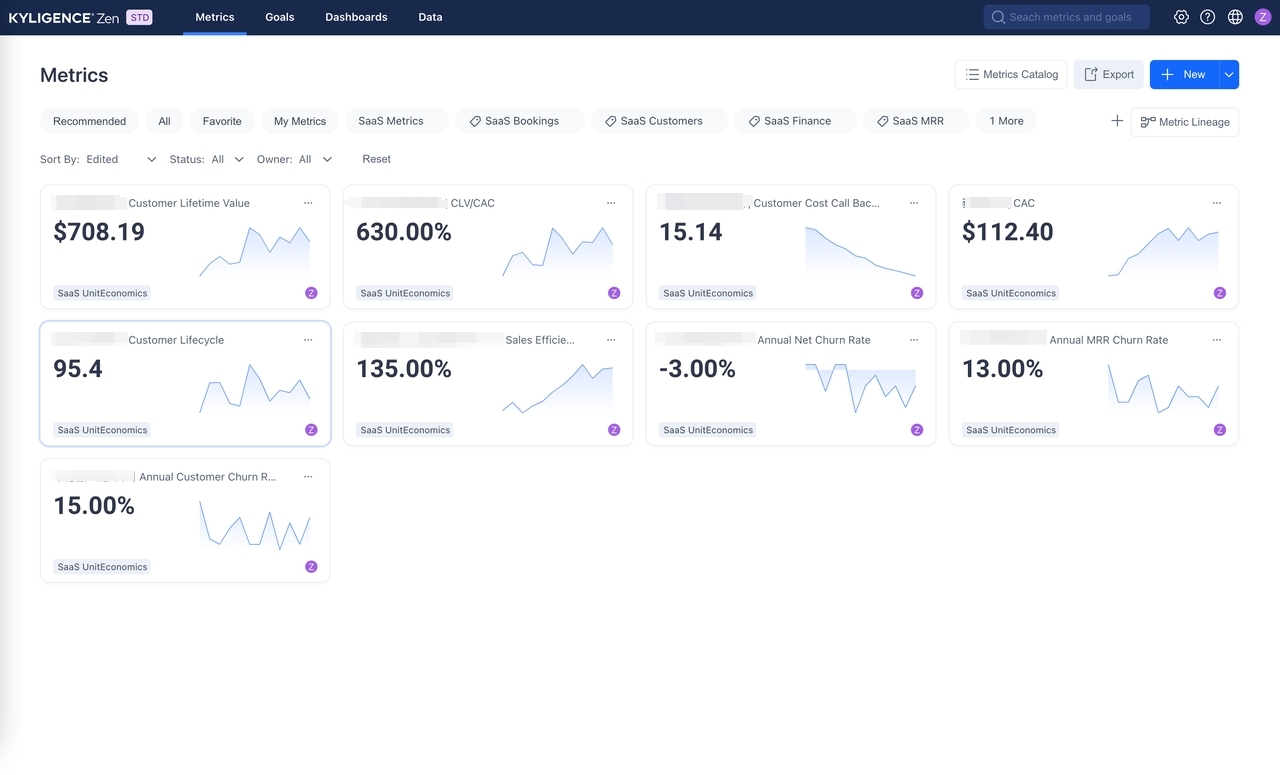Ⓒ 2023 Kyligence, Inc. All rights reserved.
Introduction
Unit economics is a crucial concept in the world of business. It refers to the analysis of the revenue and costs associated with a single unit of product or service. By understanding unit economics, businesses can make informed decisions about pricing, production, and expansion. In this blog post, we will explore the definition and importance of unit economics, as well as its components and how to calculate it. We will also provide real-life examples from various industries to illustrate the application of unit economics. Finally, we will discuss how businesses can use unit economics to improve decision-making and profitability. Whether you are a business owner, entrepreneur or investor, this post will provide you with valuable insights into the world of unit economics and its role in driving business success. So let's dive in!

Unit Economics Definition and Importance
Unit economics is a term that has gained popularity in recent years, especially in the world of startups and business. It refers to the financial analysis of a company's revenue and costs on a per-unit basis. This means that instead of looking at the overall revenue and costs, unit economics breaks it down into smaller segments such as per customer, per product or service, or per location.
Definition of unit economics
To put it simply, unit economics is the measurement of how much money your business makes from each customer or unit sold after accounting for all associated expenses. These expenses include production costs, marketing expenses, salaries, and other overheads. By breaking down these costs on a per-unit basis, businesses can identify which products or services are profitable and which ones are not.
Importance of unit economics in business
Understanding unit economics is crucial for any business owner or entrepreneur who wants to build a sustainable and profitable business. By analyzing the profitability of each unit sold, businesses can make informed decisions about pricing strategies, marketing campaigns, cost-cutting measures, and expansion plans.
Moreover, investors often look at a company's unit economics when evaluating its potential for growth and profitability. A company with strong unit economics indicates that it has a sustainable business model that can generate profits over time.
In addition to helping businesses make better decisions and attracting investors, understanding unit economics also enables companies to identify areas where they can improve their profitability. For instance, if the cost of acquiring new customers is higher than the revenue generated from those customers over time (known as Customer Acquisition Cost or CAC), then the business may need to re-evaluate its marketing strategy or pricing model.

Components of Unit Economics Model
Unit economics is a crucial concept for any business owner, entrepreneur, or investor to understand. It provides a comprehensive understanding of the financial health of a company and helps in making informed decisions. The unit economics model consists of several components that work together to determine the profitability of a business. In this section, we will discuss each component in detail.
Revenue per unit
Revenue per unit refers to the amount of revenue generated by each unit sold. This metric is essential because it helps businesses understand their pricing strategy and how much they can charge for their products or services. To calculate revenue per unit, you need to divide the total revenue by the total number of units sold.
For example, if a company generates $100,000 in revenue by selling 10,000 units, then its revenue per unit would be $10 ($100,000 ÷ 10,000). By knowing this metric, businesses can adjust their pricing strategy to maximize profits.
Cost per unit
Cost per unit refers to the cost incurred by a business for producing each unit. This metric includes all costs associated with production, such as raw materials, labor costs, and overhead expenses. To calculate cost per unit, you need to divide the total production cost by the total number of units produced.
For example, if a company incurs $50,000 in production costs for producing 10,000 units, then its cost per unit would be $5 ($50,000 ÷ 10,000). By knowing this metric, businesses can identify areas where they can reduce costs and improve profitability.
Profit per unit
Profit per unit refers to the profit generated by each unit sold. This metric takes into account both revenue and production costs and is used to determine whether a business is making money on each sale. To calculate profit per unit, you need to subtract the cost per unit from the revenue per unit.
For example, if a company generates $10 in revenue per unit and incurs $5 in production costs per unit, then its profit per unit would be $5 ($10 - $5). By knowing this metric, businesses can determine whether their pricing strategy is profitable or not.
Other unit economics metrics
Apart from revenue per unit, cost per unit and profit per unit there are two other important metrics that fall under Unit Economics: Cost of acquisition (CAC) and Customer lifetime value (LTV).
The CAC measures how much it costs a business to acquire one customer. This includes all marketing and sales expenses associated with acquiring new customers divided by the number of new customers acquired during that period.
On the other hand LTV measures how much money a customer will generate over their lifetime relationship with your business. This metric takes into account factors such as customer retention rate and average purchase frequency along with average purchase value over time.
Both these metrics help businesses understand their customer acquisition and retention strategies better which ultimately results in improved profitability.
Calculating Unit Economics
Calculating unit economics is a crucial step in determining the profitability of a business. By understanding the formula for calculating unit economics, entrepreneurs and investors can make informed decisions about their business and investments.
Formula for calculating unit economics
The formula for calculating unit economics is simple:
Unit Economics = (Revenue per Unit - Cost per Unit) / Number of Units
This formula takes into account the revenue generated by each unit sold, subtracts the cost incurred to produce each unit, and divides that by the number of units sold. The result is a measure of how much profit is being generated per unit sold.
For example, let's say a company sells t-shirts for $20 each. The cost to produce each t-shirt is $10. If they sell 1000 t-shirts, the calculation would look like this:
Unit Economics = ($20 - $10) / 1000
Unit Economics = $10 / 1000
Unit Economics = $0.01 per t-shirt
This means that for every t-shirt sold, the company generates $0.01 in profit.
It's important to note that while this formula provides a basic understanding of unit economics, it doesn't take into account all costs associated with running a business. Other expenses such as marketing, rent, salaries, and taxes should also be factored into overall profitability calculations.
Examples of unit economics calculation in different industries
Calculating unit economics can be applied to various industries such as e-commerce, SaaS, and manufacturing.
In e-commerce, companies often use customer acquisition costs (CAC) and lifetime value (LTV) to calculate their unit economics. CAC measures how much it costs to acquire one customer while LTV measures the total value a customer brings to a company over their lifetime. By comparing CAC with LTV, companies can determine if their marketing efforts are profitable or not.
In SaaS businesses, monthly recurring revenue (MRR) and churn rate are used to calculate unit economics. MRR measures how much revenue a company generates from its customers on a monthly basis while churn rate measures how many customers cancel their subscriptions within a certain period of time. By analyzing these metrics together, SaaS companies can determine if they are generating enough revenue from their customers to cover their expenses.
In manufacturing businesses, cost of goods sold (COGS) and gross margin are used to calculate unit economics. COGS measures all direct costs associated with producing goods while gross margin measures the difference between revenue generated from selling those goods and COGS. By analyzing these metrics together, manufacturing businesses can determine if they are pricing their products correctly and generating enough profit per product sold.

Using Unit Economics for Decision-Making and Profitability
Unit economics is a powerful tool that can help businesses make informed decisions, improve profitability, and achieve long-term success. In this section, we will explore how to use unit economics in decision-making and profitability.
How to use unit economics in decision-making
How to evaluate the viability of a business model
When starting a new business or launching a new product, it is essential to evaluate the viability of your business model. Unit economics can help you determine whether your business model is sustainable and profitable in the long run.
To evaluate the viability of your business model using unit economics, you need to calculate several key metrics such as customer acquisition cost (CAC), lifetime value (LTV), gross margin, and payback period. These metrics will give you an idea of how much money you need to invest in acquiring customers, how much revenue each customer generates over their lifetime, how much profit you make on each sale, and how long it takes for your investment to pay off.
By analyzing these metrics, you can determine whether your business model is viable and profitable. If your CAC is higher than your LTV or if your payback period is too long, it may be time to re-evaluate your business model.
How to make pricing decisions
Pricing decisions are critical for any business as they directly impact revenue and profitability. Unit economics can help you make informed pricing decisions by calculating the break-even point and understanding the impact of price changes on profitability.
The break-even point is the point at which total revenue equals total costs. By calculating the break-even point using unit economics, you can determine the minimum price at which you need to sell each unit of your product or service to cover all costs.
You can also use unit economics to analyze how changes in price will affect profitability. For example, if you increase prices by 10%, what impact will it have on gross margin? By analyzing these scenarios using unit economics, you can make informed pricing decisions that maximize profitability while remaining competitive in the market.
How to allocate resources
Resource allocation is another critical aspect of decision-making for businesses. Unit economics can help businesses identify which products or services generate the highest profit margins and allocate resources accordingly.
By analyzing unit economics data for different products or services within a company's portfolio, businesses can identify which products or services generate higher profits per unit sold. This information can be used to prioritize resource allocation towards high-profit products or services while reducing investments in low-profit ones.
How to improve profitability using unit economics
How to identify areas for cost reduction
One of the primary benefits of using unit economics is its ability to identify areas where costs can be reduced without compromising quality or customer experience. By analyzing various cost components such as COGS (cost of goods sold) and operating expenses using unit economics data, businesses can identify areas where they are overspending and take corrective action.
For example, if COGS are too high compared with industry benchmarks or historical data trends, businesses could consider renegotiating supplier contracts or finding alternative suppliers that offer better rates. Similarly, if operating expenses are too high compared with revenue generated per employee or per location/unit sold/rented out/etc., companies could look into ways of optimizing staffing levels or reducing overhead expenses such as rent/utilities/insurance/etc.
How to increase revenue per unit
Another way businesses can use unit economics data is by identifying opportunities for increasing revenue per customer/unit sold/rented out/etc.. This could involve cross-selling/up-selling complementary products/services/packages/bundles/etc., introducing loyalty programs/rewards schemes/referral incentives/etc., improving product/service features/quality/performance/speed/etc., expanding distribution channels/marketing campaigns/target audiences/etc..
By analyzing various factors such as conversion rates/customer retention rates/customer satisfaction scores/product ratings/pricing elasticity/etc., businesses could prioritize initiatives that have higher potential ROI (return on investment) based on their respective contribution margins (revenue minus variable costs).
How to optimize the business model
Finally, one of the most significant benefits of using unit economics data is its ability to help businesses optimize their overall business model. By continuously monitoring key metrics such as CAC/LTV/gross margin/payback period/break-even point/contribution margin/etc., companies could identify trends/patterns/opportunities/threats that require attention/correction/improvement/investment/divestment/etc..
For example, if CAC keeps increasing over time despite efforts made towards improving marketing efficiency/conversion rates/customer retention rates/product quality/features/pricing strategy/distribution channels/etc., companies may need to re-evaluate their target audience/market positioning/value proposition/business strategy/go-to-market plan/etc..
Similarly, if gross margins keep decreasing over time despite efforts made towards reducing COGS/operating expenses/improving pricing strategy/introducing new products/services/expanding distribution channels/marketing campaigns/target audiences/etc., companies may need to re-evaluate their supplier contracts/vendor relationships/employee productivity/cost structure/business diversification plan/revenue streams mix/portfolio management strategy/etc..
Track Unit Economics with Kyligence Zen
Managing and analyzing your unit economics can be a complex and time-consuming process. That's where Kyligence Zen comes in. Kyligence Zen is a low-code metrics platform that allows you to define, collect, and analyze your business metrics in one place.

Here's a simplified guide on how you can track unit economics with Kyligence Zen:
Step 1: Connect Your Data Source
With Kyligence Zen, you can quickly connect your data sources, define your business metrics, and uncover hidden insights in minutes. The platform also offers over 1000 metric templates created by industry experts, which you can easily apply to your own datasets.
Step 2: Define Your Unit Economics
Once you connect your data source to Kyligence Zen, you can create metrics using a drag-and-drop interface. Alternatively, you can leverage the metrics template made by industry experts.
Step 3: Reuse Your Metrics Across Platforms
Kyligence Zen offers flexibility in how you analyze your data. You can create customizable dashboards tailored to your specific metrics, or you can connect your metrics to Excel for a familiar, intuitive, drag-and-drop Pivot-table experience.
Moreover, with its Open APIs, Kyligence Zen ensures easy integration of your organization’s data and metrics with the BI and SaaS tools that best fit your business needs. This allows for alignment across all your business units, data consumers, and decision-makers on one unified metrics platform.
In conclusion, tracking your unit economics is essential for measuring business success. You can identify trends and adjust business strategies by monitoring your MRR, LTV, and CAC and using tools like Kyligence Zen.
Tracking Your Unit Economics with Kyligence Zen
Kyligence Zen makes it easy to connect your organization’s data and metrics with the BI and SaaS tools that make sense for your business—no matter what they are. Align all of your businesses, data consumers, and decision-makers on one unified metrics platform

Conclusion
In conclusion, unit economics is a crucial concept for any business owner or entrepreneur to understand. By calculating the profitability of each unit sold, you can make informed decisions about pricing, marketing, and overall business strategy. The components of the unit economics model provide a comprehensive framework for analyzing your business's financial health and identifying areas for improvement. Real-life examples from various industries demonstrate the versatility and applicability of this concept. Using unit economics in decision-making can help you optimize your resources and maximize profitability. By keeping a close eye on your unit economics, you can ensure that your business is sustainable in the long run. In summary, mastering unit economics is essential for any business looking to achieve success and growth.
